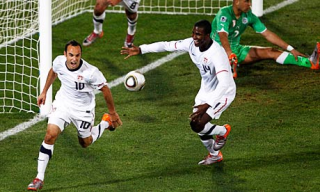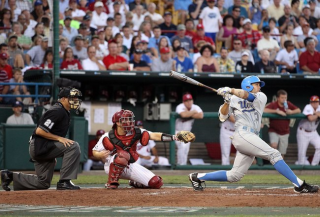|
|
|

Sports Fandom and Soccer
By Cuneiformist
Posted on: 7/15/2012
|
Why don't Americans like soccer? (Hint: What sports media pundits have been telling you is wrong.)
|

“If Landon Donovan scores a goal and
no one in the US cares, is it still a goal?” |
UEFA’s Euro 2012 has just ended (sorry, Italy fans…). For those not in the know, we’re talking about soccer and, in particular, the European championships. For most of the world, this is a big deal. After all, soccer is king in Europe — as it is in most of the world — and with all due respect to Brazil and Argentina, it is in Europe where the bulk of soccer’s supremacy lies.
In the United States, though, it’s a different story. While viewership for major events like the World Cup and the Euro have steadily grown over the years, soccer remains a fringe sport. Indeed, its (along with Canada’s) domestic league, the MLS, draws only a sliver of the TV ratings of football or basketball. Even major international events — generally heralding more famous players (e.g. Portugal’s Cristiano Ronaldo or England’s Wayne Rooney) and pedigreed nations (e.g. Germany, France, Spain, Italy, etc.) — such as the aforementioned Euro don’t command the same sorts of numbers as basketball or football.
Given soccer’s huge popularity throughout the world, it bears asking — both from a philosophical standpoint, as well as for reasons of pure marketing — why the sport has failed to catch on in the US (or Canada). Unfortunately for soccer fans, most of the major voices in sports media in the past few decades have pointed to the wrong reasons, and in doing so, they have almost certainly succeeded (deliberately or not) in poisoning a generation’s interest in the sport. Ironically, of course, this has no doubt robbed those same outlets of opportunities to financially capitalize on the popularity of a global sport.
“Too Boring”
Conventionally, when sports media figures talk about America’s lack of soccer interest, they refer to one or more of the following things: the lack of scoring, the ties, the obtuse rules, the inability to use your hands, and of course, the constant dramatic dives. One need only peruse a few articles from major newspapers to see such arguments expressed. For instance, American “super” sports agent Leigh Steinberg was quoted in a New York Times soccer blog that “soccer doesn’t fit the taste of the American sports fan, who likes a finite chance of success or failure on every play … it doesn’t have the type of pacing, like a lot of scoring. There is continuous play without scoring and the game is not susceptible to commercial breaks. Americans like fast burst of action and scoring.” Likewise, NFL football player Eric Winston wrote in a Sports Illustrated piece, “I think if soccer wants to get big in America, it needs to do what every other American sport has done: Cater to the offense. … My suggestion for soccer? Make it ten-on-ten. By taking one guy off, it will allow for the skill guys to have more space to do the amazing things that on occasion you see them do.”
As the US Men’s National Team began playing in the 2006 World Cup, sports media legend Frank Deford was quoted in a piece by Marco R. della Cava for USA Today saying, “[s]occer in America has had every chance. We reject soccer, that’s fair to say … [t]here’s not enough scoring, and ties make no sense.” He went on to add, “there’s really a lack of proficiency in the game. God didn’t intend for us to use our feet and our heads. Though what soccer players do with their feet and their heads is extraordinary, it is in the same way that spinning plates is extraordinary.”
The above comments are hardly out of the ordinary among America’s sports media elites. Moreover, they’re commonly echoed by those who post to sports message boards or call in to local sports radio programs.
Moreover, it is worth noting that these sentiments aren’t limited to soccer. When writing about the NHL lock-out that ended the 2004-05 season, Kevin Maney argued in USA Today that “[t]he game lost the creativity and scoring of the Gretzky-Lemieux era. In 1987, the NHL averaged 7.4 goals per game; in 2003-04, the average was 5.1 goals per game. Even stars such as Brett Hull complained that the game had gotten dull.” Moreover, according to Maney, “the TV networks saw other problems. Hockey is the only major sport that has a sizable number of tie games.” According to one media executive, “The U.S. audience doesn’t buy into ties.”
Thus, when the NHL resumed play, several new rules were implemented. These included a new way for dealing with ties after regulation to ensure that every game ends with a winner and loser, as well as outlawing the two-line pass, in the hopes of making it harder to defend the neutral zone and, ideally, increase scoring opportunities. Ostensibly, then, NHL and sports media executives believed that one of the main causes of the NHL’s decline was due to its low scoring and ties.

“Sweet! We tied!” |
Tired of Ties?
But is any of this true? Can it really be the case that things like low scoring and the potential for a tie game makes a sport less interesting for Americans? While this may make sense superficially, a more rigorous and thoughtful application of reason and logic suggests otherwise.
Let us first consider if it even makes sense to reasonably suggest that there is such a thing as a monolithic “American” mindset. In a country of over 300 million people and spanning a huge geographical swath — a country with a heavy influx of first- and second-generation immigrants, a country with a diverse and complex racial history — is it really possible to say that we all agree to a great extent about how we view the end result of a sporting event? Let’s not forget that there isn’t even a uniform consensus on what to call cola. Can we really imagine that there is a vast majority opinion on ties or scoring?
Moreover, consider for a moment the dialog below:Fan 1: Hey — wanna catch the soccer game today?
Fan 2: Nah.
Fan 1: Why not? The local team is playing its biggest rival. Winner makes it into the play-offs!
Fan 2: Yeah, but what if there’s not a winner? What if it ends in a tie?!
Fan 1: Uh, well…
Fan 2: Right. Exactly. So you can just keep your soccer. While this conversation is admittedly made up, can anyone imagine for a second that people really think like this — think that because a game may end in a tie, it is not worth watching?
One might also wonder why this same logic doesn’t apply to NFL football. After all, the NFL — by far the most popular professional sport in America — is the only one among the major sports that still allows for the popularity of a tie. And while ties are admittedly rare in the NFL, you never hear people voicing concerns that it is at least a possibility that thus makes something like Monday Night Football not worth watching.

“Crap. If he doesn’t score, I’m going to sleep.” |
Not Scoring
What about scoring? Anyone who has ever watched a sporting event will of course know that a score generally results in lots of cheering and celebrating (at least among fans of the scoring team). If we make the rather simplistic association that “cheering” equals greater fan excitement and interest, then it’s easy to conclude that more scoring will mean more cheering and therefore more excitement for the American fan.
But is this a valid conclusion? Consider the following scenario: In a big NFL game, Team A has the ball on Team B’s four-yard line. It’s first and goal. Team A is down by four points, meaning that they need a touchdown to win. Moreover, it’s the fourth quarter. Team A has no time-outs and just 90 seconds are left in the game.
On first down, Team A tries to run up the middle. Team B is expecting this, and they stop Team A’s running back for a short gain. It’s now second and goal from the three, with the clock continuing to tick.
On second down, Team A runs a play-action pass, hoping to fool Team B’s linebackers into stopping the run so that they can complete a pass over them in the end zone for a touchdown. Team B doesn’t bite and instead applies a lot of pressure to Team A’s quarterback. Moreover, Team A’s receivers just can’t get open. After a few seconds, the Team A quarterback rolls out of the pocket and, seeing no open lanes to run, throws the ball out of the end zone. The play is wasted, but the clock is stopped, at least.
Now there is just under a minute left. It’s third and goal from the three. Team A lines up in a spread formation, hoping to flood the end zone with receivers and get at least one in a position to catch a pass. However, after the snap, the quarterback drops back and then hands off to the running back for a draw. The back — seeing open lanes — scampers forward. Team B’s defensive tackle sees the play develop, though, and manages to separate himself from his blocker and make an ankle grab, stopping the back before he reaches the end zone.
And now it’s fourth down and goal from the one. Only seconds remain in the game. Team A lines up…
I won’t continue this scenario, but anyone who has watched enough football (at any level — high school, college, or the pros) would be familiar with it. And for those people, if the scenario ended with Team A scoring (and thus winning), we can be sure that fans of both Team A and Team B would agree that it was an exciting game. Indeed, even casual fans would have agreed that on that.
More importantly, though, it is also almost certain that if Team A hadn’t scored — if they were stopped on fourth and goal — fans of both Team A and Team B would agree that the game was exciting. Likewise, casual observers would agree with that sentiment as well. In other words, the notion that scoring equals excitement or interest is false. No one leaves a 14-10 football game saying “that was an OK game, but it would have been way better if it had been 20-14.”Fan 1: Hey — wanna catch the soccer game today?
Fan 2: Nah.
Fan 1: Why not? The local team is playing its biggest rival in the championships.
Fan 2: Yeah, but the score is going to be like 1-0, or 2-1 at best. Maybe if I knew that there would be four or five goals — you know, 3-2 or something, then I’d go. But with just one or two goals, it’s not worth it.
Fan 1: Uh, well…
Fan 2: Right. Exactly. So you can just keep your soccer. Does anyone really think like this? Of course not.
The Data
These sorts of mock scenarios help to make a point, but it’s also valuable to actually look at the data. Let’s look at scoring data for MLS soccer — the major professional soccer league in the United States and Canada, for instance. In 2009 (a recent year taken more or less at random), the MLS saw its 15 teams score 571 goals in 30 games averaging just 1.3 goals per team per game. This is a rather small number when compared to the 2009 season of Major League Baseball (MLB), where there were a total of 22,419 runs scored among its 30 teams over the course of 162 games. This average of 4.5 runs per team per game dwarfs the number of goals in a soccer game. If scoring is directly related to the popularity of a sport, then it is easy to see why soccer cannot compare to baseball.
But what about football? Unfortunately, the picture is not so clear. In the National Football League (NFL), there are two primary ways to score: touchdowns and field goals. The latter are worth three points, while the former are generally worth seven (they can be worth six or eight, depending on how things go). In the 2009 NFL season, the average team scored 343.4 points over the course of the season, or 21.4 points per game. It’s difficult to break this down into touchdowns and field goals, but it is a safe bet to say that a team scores on average fewer than three touchdowns in a game.
If we assume that the touchdown is the highlight of scoring in the NFL, then it is reasonable to assert that fans can expect to see from four to six scores per game (i.e. 2-3 per team). This is somewhat greater than soccer’s two to three scores per game — about twice as much. However, it is less by at least 33% than what is seen in baseball’s major leagues, where we see about nine scores a game. If there’s some direct correlation between scoring and interest in a sport, then the NFL’s popularity over soccer makes some sense (though, not as much as we might expect).
Moreover, given that we see even more scores in MLB games, we should expect baseball to be king in America. Unfortunately, this isn’t the case. For instance, in looking at the top television programs of the 2011-2012 television season (N.B. It used to be that network programs in the U.S. began in the fall and stretched into the late spring of the following year. Thus, television ratings are calculated in a similar way, even though the conventional format is becoming less and less common), we see that the number one program has been NBC’s Sunday Night Football. Indeed, when looking at the top individual broadcasts of 2011, only one non-NFL program — the Academy Awards — even makes the top ten. Conversely, national broadcasts of MLB games cannot compete with re-runs of television sitcoms.
Indeed, the true king of professional sports in this country — if we’re assuming that Americans like scoring and detest ties — should be basketball. After all, a typical NBA game will see each team score 80 or more points a game. Since basket can be worth one, two, or three points (with the majority being of the two point variety), it’s safe to say that a typical game will see upwards of 40 scores in a game for just one team!
Of course, while the NBA (and its college counterpart) are quite popular in the US, they don’t touch the NFL (or college football, for that matter). Clearly, then blanket statements like “Americans like sports that feature lots of scoring” are untenable given the available data, and another answer must be sought when trying to answer the question of why soccer (or any other sport) is (or isn’t) popular.

“Cheer! I’m pretty sure something just happened!” |
Preemptive Rebuttal
Before attempting to provide an alternative answer to this question, I’d like to preemptively address a likely counter-argument regarding scoring and fan interest. For those on the “Americans like more scoring” side, a compelling (superficially, at least) piece of evidence in support of their claim can be found in the most-recent college football season. In November, LSU played Alabama in a much-anticipated regular season game. But while the game ended up being a close one — LSU won by only three points — there was limited scoring as the final was just 9-6. (In overtime, no less!)
This result led to quite a bit of hand-wringing among sports media pundits. Thus, while everyone agreed that these two teams were among the best — if not the best — two teams in the country, they also agreed that the low-scoring affair was a result of sloppy play. More importantly, though, as a potential championship rematch loomed, a number of fans expressed concern that the game would be another boring low-scoring contest. Indeed, even Oklahoma State coach Mike Gundy — in trying to lobby for his team to be inserted into the championship game — argued that “people have to decide whether they want to see a 9-6 game or a 39-36 game,” suggesting that more scoring would lead to a more entertaining game.
Fans expecting a low-scoring game in the LSU-Alabama rematch weren’t far off the mark, as Alabama won the game 21-0, with the only touchdown being scored in the final few minutes of the game. The following days saw much consternation about the lack of offensive production, and one writer even quipped that “there were certainly a lot people who may have preferred a different style of game, as the 14-percent dip in overnight ratings from last year’s Auburn-Oregon title game attests.” In other words, the writer ascribed the low rating (compared to last season’s championship game) for the LSU-Alabama game entirely to the fact that fans wanted a contest that featured more scoring.
But I would argue that in fact, the outcry over the two games is just an example of not meeting what I’d term the “expected scoring range”. Every sport has a set of rules and anyone familiar with the sport has some idea of what is expected in a game in terms of scoring. As noted above, an average NFL team is scoring around 21 points a game — including several touchdowns. When a fan tunes into a game on Sunday afternoon, she or he is expecting both teams to reach the end zone a few times, and for the final score for each team to be in the range of 14-28 or so. College football — due to a variety of factors — feature even more scoring on average. Thus, when fans see a game with a lower-than-expected score, they are naturally going to be disappointed. According to the more-scoring crowd, this is evidence that fans perceive low-scoring games as boring, and desire more offense.
The flaw in that argument, however, is that particularly high-scoring games receive criticism just like low-scoring games do. In this past season of college football, for example, the best teams in the Big XII conference routinely feature prolific scoring. Yet, this wasn’t something that sports media elites celebrated as being “fun” or “exciting”. Instead, it was proof that those teams had poor defenses. Indeed, in a recap of the recent college bowl season, one writer lamented all of the scoring, noting that “[i]t all started New Year’s Day when Oregon and Wisconsin laced up their sneakers for the 98th Rose Bowl. A track meet broke out as the run-and-shoot Ducks were as defenseless as Daffy on the first day of ‘Duck Theason’ but still quacked out a 45-38 victory in the highest scoring game in the ‘Granddaddy Of Them All’ of all.”
The same holds true for other sports. While sports pundits would certainly decry an NBA game with a 60-55 result, they’d similarly have problems with one featuring a 140-135 result. Similarly, a baseball game with 40 combined runs would likely be derided by sports media pundits as one devoid of quality pitching and defensive play.
A Different Approach
If it’s true that things like ties or scoring have no real bearing on whether a person has an interest in a sport or not, then what does? As I have argued above, the answer has nothing to do with game mechanics. That is, no amount of rules-tweaking is going to make, say, curling or cricket America’s next “national pass-time.” Instead, it is clear that interest in a sport depends almost entirely on cultural, social, and historical factors.
Consider, for a moment, a typical sports fan in the state of Nebraska. Odds are, his (let’s assume for the sake of the argument that the typical sports fan in Nebraska is a male) favorite sports to watch — and the one he occupies himself with the most in terms of reading about on-line, watercooler/bar-room discussions with friends, etc. — is college football and, in particular, Cornhusker (the mascot of the University of Nebraska) football. Other sports he might follow are professional football (the NFL), college basketball and perhaps college baseball. Otherwise, there’s likely not much he’s going to devote his time to — including hockey (on all levels), professional basketball and baseball, and of course, soccer.
Conversely, if we consider a typical sports fan in the state of North Carolina, we’re going to get a different profile of interests. King for this fan is the sport of college basketball. Football (both college and pro) are behind, but not by much. Professional basketball is, perhaps surprisingly, less popular by a not-insignificant margin over its college counterpart. Other sports (e.g. hockey, soccer, etc.) hardly register for this fan.
Anyone familiar with the sports scene of the United States would read the above and find it to be rather banal. After all, the Cornhuskers have had a wildly successful college football program for generations — obviously people in Nebraska are going to take interest. Similarly, the incredible success of basketball programs at both Duke University and the University of North Carolina make them obvious focal points of sports interest in that region.
But while this may seem like a rather mundane observation, it gets to the point of my argument: fans don’t care about things like points scored or if a sport has ties or not. They care about a sport because it is culturally significant to their larger community. It’s what people talk about at work and school. It gets the most coverage on the news. It’s what your dad watched on the weekend when you were growing up.

J. Jonah Jameson Frank Deford
tells us why lacrosse rules. |
Lacrosse: The Textbook Case
If you grew up in — or otherwise spent significant time in — that region of the United States that includes northern Virginia, Washington, D.C., Maryland, Delaware, New Jersey, eastern Pennsylvania, eastern Upstate New York, southern Ontario, Connecticut, Rhode Island and Massachusetts, then you’re probably familiar with the sport of lacrosse. For the sake of brevity, we’ll call this the “Lacrosse Zone” or even just the “Lax Zone” for short. You may have heard of lacrosse even if you haven’t spent much time in the Lax Zone, but you certainly haven’t experienced the sport in the way that a person who grew up in, say, Baltimore or Syracuse has.
Outside of the Lax Zone, lacrosse is just some odd sport that maybe has something to do with Native Americans, where people run around with sticks tossing a ball around. But inside the Lax Zone, lacrosse is a premiere sporting event, rivalling only basketball among college sports fans. (I’ll talk about professional lacrosse in a bit.) When major lacrosse powers play — say, Johns Hopkins vs. Princeton, or Syracuse vs. UVA, etc. — it gets front page coverage. Indeed, local TV stations will air highlights of high school games on the news. In this Lax Zone, going to the park and seeing kids tossing a ball with their lacrosse sticks is not an uncommon sight.
When thinking about lacrosse and the popularity of sports, an important question to ask is why it hasn’t caught on and spread to other parts of the country. After all, lacrosse has relatively high scoring games (scores of the NCAA Men’s championships for the last six years have been: 9-3, 9-7, 6-5, 10-9, 13-10, and 12-11) and there are no ties. If the Americans-like-scoring crowd is correct, the popularity of lacrosse should be spreading like wildfire. Indeed, several years ago Frank Deford — a Baltimore native — noted in an NPR piece that it is “now the fastest growing in the land — participation up 300 percent in a decade.” He went on to add that while “lacrosse is compared mostly to hockey and soccer … it offers much more scoring than either of these sports. That and its manual dexterity makes it more appealing to American audiences than soccer.” (Deford’s ludicrous sentiment that accurately being able to dribble and kick a soccer ball is little more than a parlor trick, but tossing a small rubber ball around using only a stick with a small net at the end is something to be admired is a telling indicator of his own sentiment-driven agenda.)
Unfortunately, in the six years since his NPR piece, there’s been little evidence to Deford’s claim that lacrosse is taking the country by storm. While the college game remains popular, it does so largely in the Lax Zone. To be sure, some schools, such as Duke University, have seen success in the sport, but a quick glance at its roster reveals that it is populated with kids who grew up in Maryland, New York, and New Jersey. Moreover, the professional league has failed to gain a foothold and Major League Lacrosse (or MLL) has contracted from ten teams at its height down to six, and has only recently expanded to eight. The two new expansion teams (the Charlotte Hounds and the Ohio Machines) join the Denver Outlaws as being the only ones that are outside of the Lax Zone.
What is curious about the above — namely that lacrosse has, in general, failed to emerge as a major sport across America (Deford’s comments notwithstanding) — is that, as I noted, it should. Or at least, it should if you believe in the Americans-love-scoring narrative that sports media pundits like to put forward on a regular basis. That it hasn’t suggests that other factors — other more important factors — are at work.
On the other hand, its lack of unbridled nation-wide popularity makes perfect sense when one considers that interest in a sport is due entirely to cultural, historical and social factors. Lacrosse may very well become a major sport in America. However, it will only do so once a generation (or more) of Americans move from places like Baltimore, northern New Jersey, Upstate New York and so on, to other parts of the country, and continue to maintain their interest in the sport, passing on that interest to their children, working to develop local lacrosse leagues, etc.

“Man, I hope this aluminum bat brings in more fans!” |
College and Professional
This notion that social, cultural and historical factors largely dictate interest in a sport has great explanatory power — one that the Americans-like-scoring crowd lack — when considering the divide in popularity among some professional and college sports. For instance, Deford argued in his NPR piece on lacrosse that the sport seemed less like soccer or hockey (to which it is often compared) and more like basketball, with its fast-pace (and higher scoring), adding that “major league lacrosse counts two points for a long goal and has a possession clock.” The point seems to be that the professional version of lacrosse should be more exciting than even the college version. And yet it’s clear that the professional MLL is struggling — while Johns Hopkins often sells out its 8,500-person capacity stadium for lacrosse games, the fledgling MLL has a league-wide average attendance of much less, and only one team — the Denver Outlaws — draws more than 10,000 a game on a regular basis.
If scoring and fast-paced action are supposed to make a sport more appealing to fans, then why doesn’t MLL draw more attention than its college counterpart? The answer, of course, is that things like scoring have nothing to do with the interest one has in a sport. Instead, they care because they have an emotional attachment to a team and a league built up over years and generations.
While this isn’t the place to get into the history of the sport of football in the U.S., it is well known that the NFL in the 40s and 50s hardly held the appeal that it does today, and indeed was less popular than its college counterpart. This changed over time to the point where, at present, the NFL is by far the most popular sports league — college or otherwise — in the country. But these changes in fan interest can hardly be ascribed to major rule changes. Instead, they can be attributed to things like demographic shifts, media coverage and so on.
Without question, the biggest discrepancy between college and professional popularity is with baseball. While both college and professional football and college and professional basketball enjoy wide popularity, college baseball is scarcely on the sports radar when compared to the major leagues. However, this shouldn’t be the case if we subscribe to the Americans-love-scoring argument. After all, college games feature far more scoring than MLB games. As noted earlier, major league baseball teams typically score just over four runs a game. As we approach this year’s All-Start break — the half-way point in baseball’s 162-game season — major league baseball teams have scored on average about 332 runs. Conversely, at the conclusion of the Division-I NCAA baseball season, 332 runs puts you at approximately 97th place (out of 291) on the list, with no NCAA team having played even 70 games. Indeed, the three teams that scored 332 runs this season (Arkansas State, James Madison, and Texas Southern) played between 53 and 57 games, meaning they averaged over six runs a game. If fans really cared about scoring, they should be tuning in each week to see high-scoring college baseball far more than the rather dull professional version.
But of course, fans don’t care about high scoring. They care about what has cultural significance, and about what is relevant in their social circles. A person living in Georgia may care about Georgia Tech athletics, but he or she almost certainly cares more about the Atlanta Braves more than Georgia Tech baseball, even though the college team far outpaces the professional one when it comes to runs scored.
What Next?
If the above analysis is true (and let’s be clear: it is), then where do we go from here? What does a MLL or MLS executive do with this? What does an ESPN higher-up do? Unfortunately, there aren’t easy answers. After all, becoming culturally and socially relevant in the sports landscape of a large, diverse country isn’t easy — especially when some sports have a firm grasp of huge pieces of the pie.
Nevertheless, there are options. I’ll save my own answers for, perhaps, a different article or let others discuss them. However, whatever one does, that person must do so realizing that they must be in for the long haul. Part of the appeal of the Americans-like-scoring (or don’t like ties, or whatever) argument is that it meant there was the potential of a quick fix — if you just tweaked the rules a little bit, people would suddenly have interest in your sport, and you’d save it! But the reality is different. Eliminating ties didn’t suddenly launch hockey to the sports forefront and adding two-point shots in professional lacrosse isn’t going to turn it into America’s next major sport — much to Frank Deford’s chagrin. Instead, one has to consider other factors — factors that involve time, money, and, ultimately, a more sophisticated understanding of why people like what they like in the first place.
Read or Add Comments about this Article
|
|
|
Back to Skeptillaneous
|
![]()